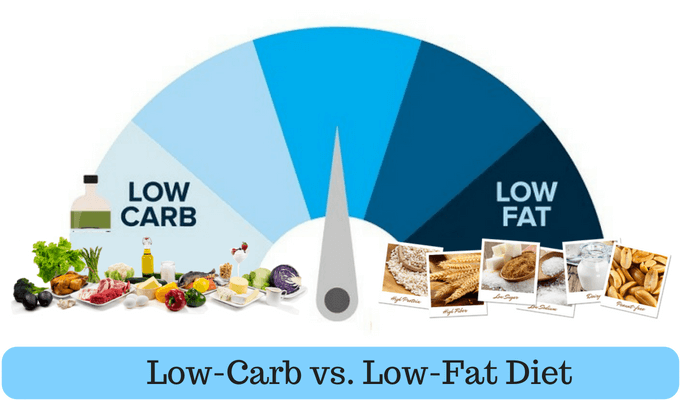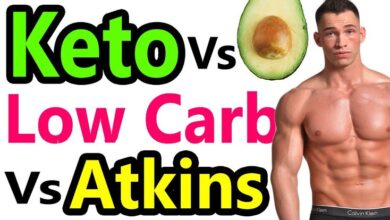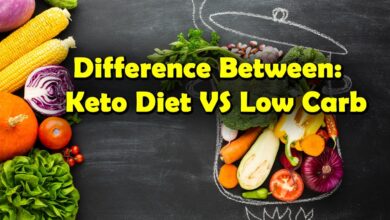
When it comes to transforming your diet, two giants loom large: keto and low-fat. You’ve probably heard people swear by keto for rapid fat loss, while others champion low-fat for heart health and sustainability. But which one is truly better — or better for you? In this deep dive, we’ll unravel the science, weigh benefits and drawbacks, and help you decide which path fits your body, goals, and lifestyle best.
In this article, you’ll get:
- An understanding of how ketogenic and low-fat diets work
- Comparisons on health, performance, longevity, and sustainability
- Practical guidelines, pitfalls, and customization strategies
- Real-life case studies and decision trees
- Answers to common FAQs
So buckle up — we’re going far deeper than just “low carb vs. low fat.” Let’s get started.
1. What Exactly Is a Ketogenic Diet?
A ketogenic diet (or keto) is one in which carbohydrates are severely restricted (often to under 20–50 g per day) and fat becomes the primary fuel source. The body shifts into a metabolic state called ketosis, in which it produces ketone bodies (e.g., beta-hydroxybutyrate) to supply energy.
Read Also Keto vs Low-Fat Diet for Weight Loss: Which Works Faster and Smarter for You?
To achieve this, most keto diets are composed of roughly:
- 70–80% of calories from fat
- 10–20% from protein
- 5–10% from carbohydrates
In this setup, your body adapts to burn fat — including stored body fat — for fuel. That’s the hallmark appeal of keto diets: fat burning, appetite suppression, and improved metabolic markers in some people.
Key features:
- Very low carbohydrate intake
- Moderate protein
- High fat (especially healthy fats like olive oil, avocado, nuts, seeds)
- Elimination or near-elimination of sugar, refined carbs, and many grains
That said, there are variants: targeted keto, cyclical keto, and more liberal “modified keto” versions. Some people may allow slightly more carbs (e.g., 30–50 g) or use carb cycling around workouts. Regardless, the core concept remains: shift fuel from glucose to fat/ketones.
2. What Is a Low-Fat Diet?
On the opposite side, a low-fat diet emphasizes reducing dietary fat, often below 20–30% of total calories, while permitting higher carbohydrate and moderate protein intake. Historically, low-fat diets have been pushed for heart health, cholesterol control, and weight management.
Typical macronutrient breakdown:
- 50–65% of calories from carbohydrates
- 15–25% from protein
- 20–30% (or less) from fat
Proponents of low-fat argue that since fat is calorie dense (9 calories per gram vs. 4 for carbs or proteins), reducing fat automatically reduces overall energy intake. Also, such diets often prioritize whole grains, legumes, fruits and vegetables, which provide fiber, micronutrients, and satiety.
Some common forms include:
- Very low-fat (e.g. Ornish style) — <10% fat
- Moderate low-fat — 20–25% fat
- Plant-based low fat — emphasizing plants and little added oils
3. Comparing the Mechanisms: How They Work (and When They Don’t)
3.1 Fuel Source and Metabolism
In keto, with carb intake so low, glycogen (stored carbohydrate in muscles and liver) becomes scarce. Your body starts converting fat into ketones, which serve as alternative energy for many tissues, including the brain. This shift can reduce insulin levels and improve insulin sensitivity in some individuals.
In a low-fat diet, the body still primarily runs off glucose and dietary carbohydrates. The idea is that by reducing fat intake, you reduce calorie density and prompt a metabolic environment favorable to weight loss (assuming you maintain an energy deficit).
3.2 Hormonal Effects
Keto tends to lower insulin dramatically, increase levels of glucagon, and sometimes raise adiponectin (a hormone associated with fat burning). It also usually leads to appetite suppression, possibly through ketosis’s effect on ghrelin (the hunger hormone).
A low-fat diet may help reduce LDL cholesterol and total cholesterol in some individuals. However, if overdone with refined carbs, it can spike triglycerides. The balance matters. Also, higher insulin levels might persist, which is disadvantageous for people with insulin resistance or metabolic syndrome.
3.3 Efficiency of Fat Loss
Under controlled trial settings, keto often leads to faster early weight loss, partly due to water loss (glycogen holds water) and reduced appetite. Over longer periods (12 months, 24 months), many studies show comparable weight loss between keto and low-fat, once caloric intake is matched.
So, is one “better”? It often comes down to adherence rather than inherent superiority.
4. Health Impacts: Risks and Rewards
4.1 Cardiovascular Health
- Keto: Can increase HDL (“good cholesterol”) and reduce triglycerides. But in some people, it raises LDL (particularly LDL-cholesterol or “pattern A” particles).
- Low-Fat: Historically recommended to reduce LDL cholesterol and reduce heart disease risk. Especially if fat is replaced with whole foods (not refined carbs).
The net effect depends heavily on fat quality (saturated vs unsaturated) or carb quality (refined vs whole). A low-fat diet packed with sugar is worse than moderate fat from olive oil and nuts.
4.2 Blood Sugar, Insulin Resistance, and Diabetes
Keto often yields dramatic improvements in blood glucose control, HbA1c, and insulin sensitivity in people with type 2 diabetes or prediabetes. Many trials show keto can reduce or eliminate the need for medications (under medical supervision).
Low-fat diets can help too, especially when emphasizing fiber, whole grains, and minimizing sugar, but the improvements are generally more modest compared to keto in insulin-resistant populations.
4.3 Inflammation, Oxidative Stress, and Gut Health
- Keto: Some studies show reductions in inflammation markers (e.g. CRP) but it depends on food choices (processed meats, low fiber can worsen gut microbiome).
- Low-Fat: Higher fiber intake (via fruits, veggies, legumes) supports gut health, diversity, and anti-inflammatory effects.
Whether one is “healthier” is context-dependent — personal genetics, baseline health, microbiome, and dietary quality matter.
4.4 Nutrient Deficiencies and Risks
With keto, risks include:
- Electrolyte imbalances (sodium, potassium, magnesium)
- Nutritional deficiencies (vitamin C, some B vitamins, fiber)
- Keto flu, fatigue, digestive issues
- Long-term unknowns (especially around bone health, kidney function, and cholesterol in susceptible people)
With low-fat, potential pitfalls include:
- Overconsumption of refined carbs or sugar
- Lack of essential fatty acids (omega-3, omega-6)
- Hunger or lack of satiety if not properly balanced
5. Performance, Exercise & Body Composition
5.1 Strength Training and Muscle Growth
In strength athletes, sufficient protein is key. Keto can work, especially when protein is preserved and carbs are timed or cycled. But it’s more challenging to build maximal muscle when glycogen is chronically low.
In low-fat, higher carb availability can support more intense training, better glycogen replenishment, and potentially better hypertrophy (muscle growth).
5.2 Endurance, Stamina, and Fatigue
Keto proponents argue you become a “fat-burning machine” — benefiting ultra-endurance events or long sessions where fat oxidation is crucial. Some long-distance athletes report success.
But for high-intensity, anaerobic bursts (HIIT, sprints), carbs are superior. Many athletes use targeted keto or carb cycling to allow performance during heavy sessions.
5.3 Adaptive Issues: “Keto Flu,” Energy Slumps, and Plateaus
Switching to keto can cause a transitional period: fatigue, brain fog, irritability, headaches, muscle cramps—collectively known as the “keto flu.” Ensuring hydration, electrolytes, and gradual adaptation helps reduce this.
On low-fat, energy slumps may happen if carb choices are poor or blood sugar swings are common. Some people may feel hungry more often unless protein and fiber are prioritized.
6. Sustainability, Psychological Aspects & Social Life
6.1 Adherence and Lifestyle Fit
No matter how “effective,” a diet you can’t stick with won’t achieve results. Keto is stricter, more limiting. Some people love the clarity and simplicity; others find it too rigid, especially socially.
Low-fat tends to be more forgiving, more socially adaptable (e.g. easier inclusion of grains, fruits, moderate fats) — but can also invite more temptation (sweet foods, refined carbs).
6.2 Food Choices and Variety
Keto can feel repetitive: bacon, eggs, meats, cheeses, low-carb vegetables. If you dislike or’re sensitive to those, it may feel restrictive.
Low-fat diets open doors to more fruits, whole grains, legumes, and higher-volume foods. For some people, that variety is more satisfying long term.
6.3 Psychological Impact and Food Cravings
Keto can suppress appetite, which helps some people avoid overeating. But for others, the strong restriction can fuel cravings, binge urges, or stress around “cheating.”
Low-fat might allow more “normal” foods, but if carbs are overconsumed, it could lead to sugar cravings or energy rollercoasters.
6.4 Social and Dining Out Challenges
On keto, many restaurant meals (bread, pasta, rice) are off-limits. You need to adapt, request modifications, or choose carefully.
Low-fat offers more flexibility, though you still may need to steer away from deep-fried or high-oil dishes.
7. What the Research Says: Trials, Meta-Analyses & Evidence
7.1 Weight Loss Trials
Many randomized controlled trials (RCTs) show that over short term (3-6 months), keto diets often produce greater weight loss than low-fat diets. But over long term (12–24 months), results usually converge when total calories are similar.
A meta-analysis might say: initial advantage for keto, but adherence and diet quality drive long-term outcomes.
7.2 Metabolic & Cardiovascular Trials
Keto often shows better improvements in triglycerides and HDL, sometimes better glycemic control. But some meta-analyses flag concerns about LDL rise or sustainability of improvements beyond one year.
Low-fat diets show consistent LDL improvements, especially when saturated fat is limited and replaced with polyunsaturated fats.
7.3 Subgroup Effects & Personalization Evidence
Some evidence suggests people with insulin resistance, metabolic syndrome, or type 2 diabetes benefit more from keto. Others (especially those with lipid sensitivity, familial hypercholesterolemia, or gallbladder issues) may fare better or safer on moderate fat intake.
Also, genetic and microbiome factors appear to mediate response; one person’s ideal diet might differ from another’s.
8. How to Decide: A Step-by-Step Evaluation Framework
Here’s how you can systematically evaluate which diet is likely better for you:
8.1 Define Your Primary Goal
- Weight/fat loss
- Blood sugar/diabetes control
- Heart health / cholesterol
- Athletic performance
- Sustainability / lifestyle
Your goal influences which tradeoffs you accept.
8.2 Assess Your Health Profile & Risks
- Do you have insulin resistance or metabolic syndrome?
- Do you have a history of high LDL cholesterol or familial lipid issues?
- Renal, liver, or gallbladder issues?
- Gastrointestinal sensitivity, food allergies, etc.
8.3 Evaluate Your Food Preferences & Psychological Fit
- Do you love meat, eggs, full fats, or more plant-based, volumetric foods?
- Are you comfortable with restriction, or do you prefer flexibility?
- Social life, travel, dining out — which diet would you find easier to maintain?
8.4 Test a Trial Phase
Try each diet for a month (or 6–8 weeks), measure energy, mood, performance, satiety, body changes, biomarkers. See which one “feels” better and yields progress.
8.5 Combine or Hybrid Approaches
You don’t have to pick 100% one or the other forever. You might use cycling, carb refeed days, or balanced moderate diets (e.g., 40/30/30) that combine elements of both.
9. Practical Guide to Implementing Keto (Safely)
9.1 Macro Setup & Food Choices
- Choose high-quality fats: olive oil, avocado oil, nuts, seeds, fatty fish
- Focus on nonstarchy vegetables (spinach, broccoli, zucchini, cauliflower)
- Moderate protein from eggs, poultry, fish, lean meats
- Limit carbs drastically — no sugar, bread, rice, pasta (except very limited)
- Use MCT oil, coconut oil, or exogenous ketones (if desired)
9.2 Transitioning & Minimizing Keto Flu
- Gradually drop carbs over 1–2 weeks, rather than overnight
- Ramp up hydration and sodium (carry a water bottle with electrolytes)
- Supplement magnesium and potassium if needed
- Get plenty of rest, sleep, and avoid overtraining in the first week
9.3 Monitoring and Adjusting
- Track ketone levels (blood testing, breath, or urine strips)
- Monitor lipid panel, liver enzymes, kidney function periodically
- Ensure you’re getting micronutrients (vitamin C, fiber, B vitamins)
- If LDL skyrockets, reevaluate fat sources and possibly introduce more monounsaturated fats
9.4 Overcoming Challenges
- For cravings: allow very low-carb “treats” (e.g., berries, high-cocoa dark chocolate)
- For social meals: eat ahead, bring your own, or choose meat & salad
- In plateaus: add more variety, cycle carbs, or re-check caloric intake
10. Practical Guide to Implementing Low-Fat (Safely and Smartly)
10.1 Macro Setup & Food Choices
- Use lean proteins: chicken breast, fish, legumes, low-fat dairy
- Prioritize whole grains (brown rice, quinoa, oats), fruits, legumes
- Vegetables in abundance
- If using fats, choose small amounts of olive oil, nuts, seeds
- Avoid refined carbs, sugary drinks, baked goods
10.2 Transitioning Smoothly
- Gradually reduce added oils and high-fat foods
- Replace them with high-fiber alternatives: more vegetables, beans, fruit
- Increase volume (bulk your meals) to reduce hunger
10.3 Monitoring & Adjustments
- Track energy, mood, hunger levels
- Monitor triglycerides, HDL, LDL
- If you feel unsatisfied or hungry, ensure protein and fiber are sufficient
- Avoid relying too heavily on refined carbs
10.4 Overcoming Challenges
- Combat sugar cravings by including fruit, yogurt, or legumes
- Eat smaller frequent meals if blood sugar dips
- When dining out, choose steamed, baked or grilled options, skip heavy sauces
11. Decision Matrix: When Keto or Low-Fat May Be Better
| Situation or Goal | Likely Better Choice | Reasoning / Cautions |
|---|---|---|
| Insulin resistance / Type 2 diabetes | Keto | Dramatic blood sugar improvements, insulin reduction |
| Elevated LDL or familial hypercholesterolemia | Low-Fat (or moderate fat) | Keto might raise LDL; safer lipid profile |
| Need flexibility, social life | Low-Fat | Easier to adapt, more food options |
| Want fast early weight loss | Keto | Rapid water and fat loss early |
| High-intensity performance | Low-Fat or hybrid cycle | Carbs support high-intensity bursts |
| Preference for full-fat, animal foods | Keto | Aligns with taste and satisfaction |
| Love grains, legumes, fruit | Low-Fat | Easier inclusion, more variety |
| Sensitive digestion, kidney or liver issues | Moderate or tailored | Keto may stress organs in some people |
Use this table as a guideline — always evaluate your individual response.
12. Case Study Examples & Real-World Stories
Imagine Jane, in her early 40s, with prediabetes and a 30 lb weight loss goal. Keto worked wonders for her blood sugar: within 8 weeks, her fasting glucose dropped, HbA1c improved, and she lost 15 lb. She enjoyed fats and had no problem avoiding carbs. She continued long term.
In contrast, Mark, in his 50s, had cholesterol concerns (LDL already moderately high). He tried keto but saw LDL spike dramatically. He shifted to a moderate low-fat diet that prioritized whole grains, legumes, and lean protein. Over months, his LDL fell and his weight still trended downward, albeit more slowly.
Then there’s Lara, a recreational runner. She cycles: mostly low carb/keto on non-training days, higher carbs around her hard workouts. She enjoys the flexibility, energy, and performance balance.
These stories highlight that context and adaptation matter more than dogma.
13. Tips for Transitioning from One Diet to the Other
If you’re currently on a standard mixed diet and want to transition:
From Western Diet → Keto
- Gradually decrease carbs (e.g. drop 25 g every few days)
- Increase fat intake in parallel
- Monitor mood, energy, and digestion
- Use a “bridge” phase: 100–150 g carbs, then 50–80 g, etc.
- Consider medical clearance if you have chronic disease
From High-Fat or Liberal Keto → Low-Fat
- Gradually swap high-fat choices with leaner ones
- Introduce more whole grains, legumes, fruits
- Monitor fullness and satiety — you may need more volume
- Adjust calories downward if weight maintenance stalls
If You Want to Switch Mid-Plan
Be patient. Expect a 1–2 week adaptation period (e.g. keto flu in reverse). Track your metrics and don’t panic at transient fluctuations.
14. Hybrid Models & Third Options
You don’t have to pick a side; many people succeed with hybrid or flexible strategies:
- Cyclical Keto: Periods of strict keto, interspersed with higher-carb days (e.g. on weekends or training days)
- Targeted Keto: Add 20–50 g carbs around workouts
- Moderate Balanced Diet (40/30/30 or 35/35/30): A more middle-ground plan combining benefits of both approaches
- Low-Carb Mediterranean / MIND Diet: Moderate in fat, but emphasizes healthy fats and fiber
- Whole-food omnivore: Use intuitive eating, focus on quality, and let macros vary naturally
These flexible strategies often win on adherence.
15. Common Mistakes & Pitfalls to Avoid
15.1 In Keto Plans
- Relying on saturated fat and processed meat excessively
- Neglecting fiber and micronutrients
- Ignoring sodium and electrolytes
- Expecting instant miraculous results
- Over-restricting calories (undereating) leading to burnout
15.2 In Low-Fat Plans
- Swapping fat for refined carbs (e.g., white bread, sugary cereals)
- Underestimating the importance of fat for satiety and hormones
- Neglecting protein (leading to muscle loss)
- Frequent snacking on “low-fat” but sugary foods
15.3 For Both Diets
- Not accounting for calories — even perfect macros won’t override too many calories
- Ignoring individual variation — what works for one might not work for you
- Giving up too early — adaptation takes time
- Failure to track or benchmark progress
Conclusion
Deciding between keto vs low-fat as your diet plan isn’t about which is “best” universally — it’s about which is best for you. Keto offers potent advantages in fat burning, blood sugar control, and appetite suppression, but with higher restriction and possible lipid risks. Low-fat offers flexibility, fiber richness, and tradition in chronic disease prevention — but can struggle if dominated by refined carbs.
The real power lies in applying a structured evaluation: define your goal, assess your health, trial both strategies, and favor the path you can sustain. You may even blend or cycle. Remember: consistent progress over months, energy, mood, health markers, and enjoyment matter far more than dogmatic allegiance.
Now go ahead: pick your starting point, commit to consistency, listen to your body, and adapt as needed. You’ve got this — whether you go fat or lean in your dietary path.
Read Also Keto vs. Low-Fat Diets: The Ultimate Guide for Lasting Weight Loss Results
Frequently Asked Questions (FAQs)
1. Which diet burns more fat — keto or low-fat?
Both can produce fat loss if you maintain an energy deficit. Keto often delivers faster early results (including water loss), but over the long term (12+ months), weight loss tends to equalize when calories and adherence are matched.
2. Is high LDL cholesterol a contraindication for keto?
In some individuals, yes — if your LDL rises dramatically, especially LDL particle number or small-dense LDL, you might reconsider. Always monitor lipids under medical supervision and if needed, shift to moderate or low-fat options.
3. Can athletes or gym-goers thrive on keto?
Yes — but performance in high-intensity, anaerobic efforts may suffer due to limited glycogen. Many athletes adopt targeted or cyclical keto: strategic carbs around training sessions to support performance while maintaining fat adaptation on other days.
4. Is there a “best” hybrid or middle-ground diet?
Absolutely. Many people succeed on moderate-balanced diets (e.g. 40% carbs, 30% protein, 30% fat), or hybrid models combining low-carb and occasional higher-carb days. Flexibility often boosts long-term adherence.
5. How long should I try each diet to see if it’s right for me?
Give each diet a fair trial of 6 to 8 weeks. Track energy, mood, satiety, body changes, and lab markers. That’s typically enough to assess which plan suits you, though full adaptation (especially for keto) may take up to 12 weeks in some.




